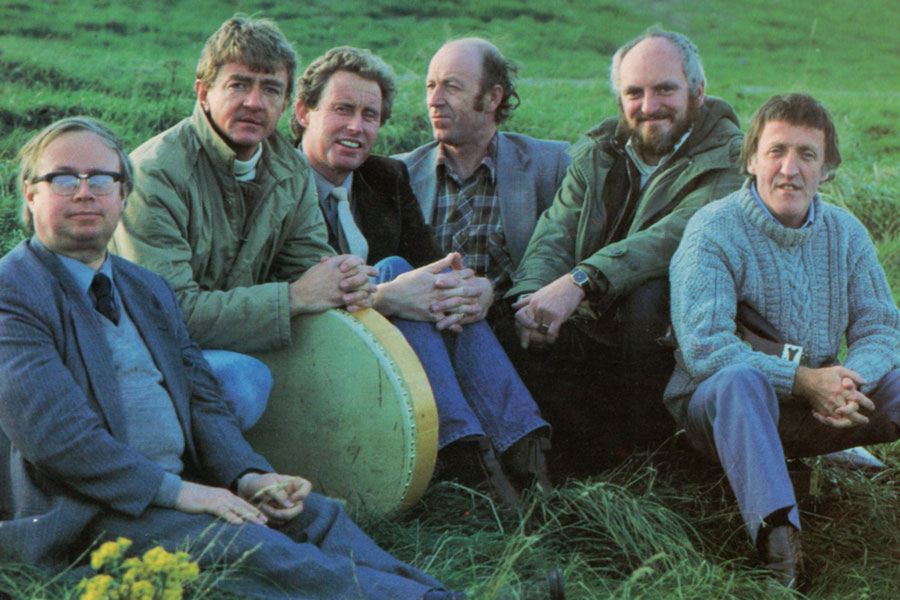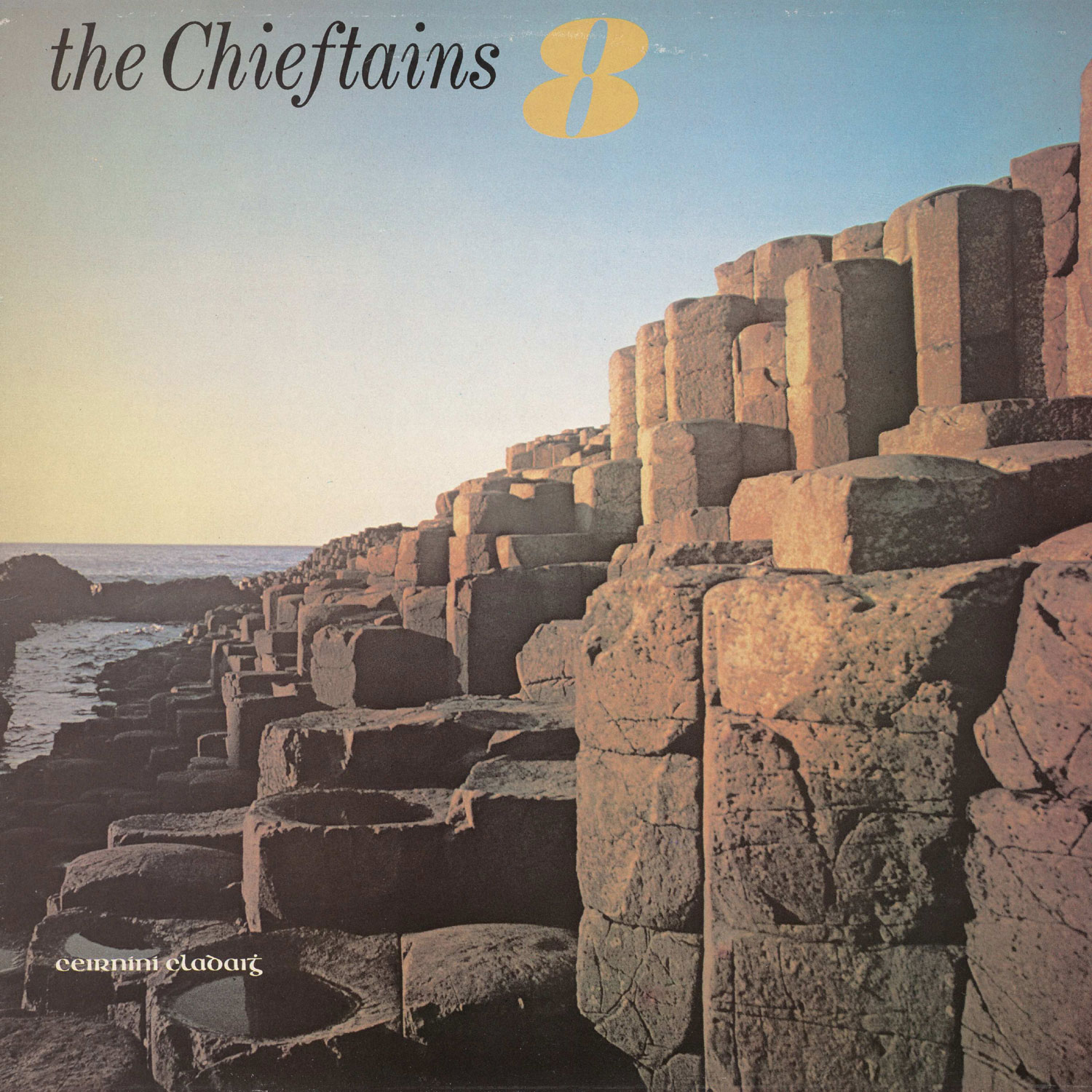


Sleeve Notes
The Session — Three jigs are arranged here to be near typical of a session by a group who would meet occasionally to have a gas and make good music. It starts with Elizabeth Kelly's Delight, a 9/8 jig which comes in again after the second tune, Fraher's, and before the third, Dinny Delaney's — two 12/8 jigs. With the return of Elizabeth Kelly's we hear Paddy Moloney give the tune a change of tone quality by playing it on a flat pitched chanter, made by Michael Egan in the last century and lent by Dan O'Dowd. Fraher's jig took its name from Edward Fraher, a piper born in 1804 in Emly, Co. Tipperary from whom it was first heard.
Dinny Delaney's (also called The Old Hag at the Kiln) was first heard played by Dinny Delaney, a blind piper from Ballinasoe, Co. Galway, at the Dublin Feis in 1899.
It was there that it was recorded — and kept alive for generations to come — on the then new fangled Ediphone cylinder recording machine. Incidentally this tune and Elizabeth Kelly's is available in Ceol Rince na h 'Eireann Cuid 2 by Brendon Breathnach.
Doctor John Hart — What Chieftains offering would be complete without a work by the great Carolan? Turlough O'Carolan (1670-1738) wrote primarily for patrons and was not averse to somewhat over ecstatic praise of the people who fed him, wined him, and paid him. Thus we have the blind harper expressing the wish in one of the verses of this song that Dr Hart would be made a bishop and refers to him as a 'true steward of the King of Glory.'
Whether Carolan was partly responsible or not, the good doctor was indeed made a bishop, of Achonry, in 1735.
The beginning of the tune is played exactly as handed down by traditional harpers, but in the middle Dr Hart seems to have got himself involved in a 'wee bit of a hooley,' as Derek Bell describes it, for there are two short dance variations. One variation is a kind of Strathspey, suggesting Scottish Visitors — -musically appropriate in view of the Scottish flavour of the melody. The other variation is a fast jig. Finally, as though our friendly bishop were to reappear in the doorway to bless the party, part of the tune is played once more in its original form.
Seán Sa Cheo — Seán Keane is in great whimsical form at the opening to Seán Sa Cheo (Seán in a fog). There is almost a touch of the Grappelli in his playing and a hint of Rumanian and Paraguayan styles as the variations counter each other and build towards the reel itself. The tune, incidentally, is derived from The Donegal version by the fiddler Johnny Doherty.
Hornpipes — From a reel we move into two good meaty hornpipes. The first Ant Seán Bhean Bhocht (The Poor Old Woman) is one of the many poetic names for Ireland in its long and troubled history. The first line of the song goes 'Oh the French are on the sea says the Seán Bhean Bhocht' telling of the reliance Ireland had on help from France. Then the harp and bodhrán mingle magically to take us into The Fairies' Hornpipe which is later picked up by the whole band.
Sea Image — A tone poem, or in the rather less fanciful language of the Chieftains, a 'set piece' celebrating Ireland's association with the sea. The suite opens with an image of the vast expanses of water surrounding the Gaels. The pipes and fiddle drone set the mood and this in time gives way to the bodhrán's portrayal of a giant breaker. This starts the whistles and tiompán into the rythmical introduction to the piece.
Martin Fay's slow air serves as a warning of the dangers that hide in the sea. Then off we go with the voyage. It could be a journey to find new fishing pastures — or a land with new hope. The piece progresses through the calm, slowly building and building into a storm. The plaintiff lament of the pipes playing Anach Cuan depict an actual boat tragedy which in turn goes to calm. Then we roll on with the double jig The Rolling Wave with which the suite ends.
If I Had Maggie In The Wood — Side two opens in typically spirited fashion with three polkas commonly played at house dances. These types of tunes would often have words sung to the music. They would normally be comical or satirical and the lines sung by Kevin Conneff on this track are comical alright — though certainly not terribly subtle as you can judge for yourself when you listen to the track.
An Speic Seoigheach — A beautiful slow air which illustrates perfectly the depth of the Chieftains' playing. It is romantic, melancholy, emotional, yet never loses its sense of hope. In its own way it is an image of an Ireland of centuries past and of Ireland today. Timeless and haunting. It was because of its evocative qualities that the air was chosen to be part of the Chieftains ' score for Patrick Carey's film on Ireland 'Reflections.'
The Dogs Among The Bushes — This set starts with the Scottish Strathspey Athol Brose, played with an interesting mixture of the rich Scottish and Irish traditional styles. Then back to the roots for the related Irish reel The Dogs Among the Bushes. Heaven knows who can lay claim to originating the reel but what matter — just listen to it and enjoy yourselves.
Miss Hamilton — This, alas, is the only surviving tune by the 17/18th century harper and composer Cornelius Lyons, though we still have his variations on several well known airs. Lyons was a rival of the best known of Ireland's harper/composers Carolan (best known that is until Derek Bell came along) but while Carolan shows the influence of the Italian school. Lyons shows a leaning towards the German baroque style.
Listen to this beautiful air and imagine yourself transported to an old castle in ancient times. You are hearing a mediaeval Irish ensemble of pipes, harps, tiompáns and the precursors of whistle, fiddle and bodhrán. Notice in the second half of the tune the carillon of fairy bells — or is it wedding bells? Could it be, in fact, that Miss Hamilton was about to marry?
The Job Of Journey Work — Martin Fay starts off the set with superb fiddle playing of an air related to the popular set dance The Job of Journey work. The rest of the band take up the theme and move into the main tune with great gusto.
The Wind That Shakes The Barley & The Reel With The Beryle — Out we go with two spirited reels arranged to suit the first two figures of the Caledonian Set as danced in West Clare — one reel for each figure. These tunes were also popular among the musicians at the house dances and the versions here were learned from the late Mrs Crotty of Kilrush, the concertina playing relation of Michael Tubridy. The first reel is named The Wind That Shakes The Barley and the second The Reel with the Beryle, a West coast version of the well known Drowsy Maggie, a very different offering of which can be heard on Chieftains' 4. This reel is played one time more than would be needed for the dance but then if spirits were high at the end of a figure a dancer would shout 'House it again!' and on the dancers would go for another round. And another and another … One interesting point — instead of the dancers battering out the beat with their feet, Kevin Conneff uses two bodhráns on this track to achieve the same effect. This has two advantages — it sounds great and it saves dancers from electrocuting themselves by tripping over cables in a recording studio!
Alan Frame